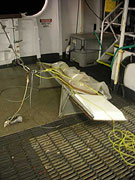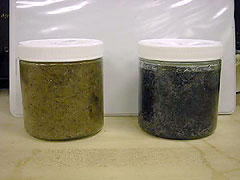

 | |||||||||||||
|
|
Journals 2007/2008Heather Judkins
November 9, 2007 Today was an XBT, bongo, and manta net tow day for me. The XBT's went down 4 times throughout the day and I am going to explain what happens with the manta net. The manta net is designed to capture plankton that is at the surface of the water column. There is a flowmeter attached as with the bongo nets for water volume flowing through the net. It is towed for 15 minutes before it comes out of the water. Once out of the water, the sample gets rinsed and put into formalin to be volumized and counted at a later date. The plankton trapped in the manta net are primarily copepod species as well as fish larva. Occasionally there will cephalopod species as well. The difference in the samples from the bongo and manta tows is easily observed as the collected samples sit side by side. The lighter colored sample is from a bongo tow and the blueish sample comes from the manta tow. The blue color in the manta net is due to copepods. These zooplankton can range in color from blue, purple, pink, to red in color. The ones found at the surface tend to be the "blue" colored species.
I also saw a large container ship passing by us today. This is only the second ship to come within range of binoculars in our 6 days at sea so far. The ship I saw yesterday was a Tuna ship from Manzanilla, Mexico which can stay out at sea for up to 6 weeks before returning to port with their catch. The container ship I saw today was 293 m long and had approximately 2500 containers on board! The containers can carry anything from cars and T.V.'s to toilet paper and cleaning supplies. It looked absolutely enormous even from 5 miles away! This one was headed for Panama. There is an identification box that is on the McArthur II's bridge which has information about ships passing within the radar range. It will tell the ship name, destination port, and speed and direction it is moving. This ship was moving at 21 knots. The ship usually has a crew of 15-20 while underway. On a sad note, the mammal observers also spotted an Olive Ridley turtle today that was horribly entangled in some kind of fishing line. There was no way to rescue it and it appeared to have tangled for quite some time. It didn't look like it was going to survive. So, we saved a turtle from a drift net yesterday just to see another entangled today. Marine Science Questions: 1. If the container ship was moving at a speed of 21 knots, what does that convert to in miles per hour? 2. Research where container ships come in/out of Florida. Where are the major ports for them? What do they primarily carry? What type of ships primarily come into Tampa Bay? |
||||||||||||

